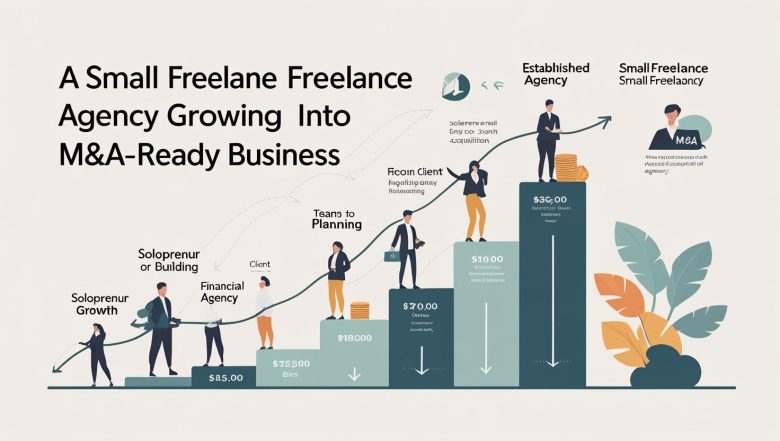From Freelance Hustle to M&A-Ready: How Small Agencies Can Prepare for a Strategic Sale
Most IT services firms don’t begin as “firms” at all. They start with one person, a laptop, and a handful of projects—late nights juggling client calls, proposals, and delivery.
Over time, a few clients return. A part-time contractor becomes a full-time hire. A logo gets designed. Maybe even an office lease is signed.
Then comes the inevitable founder question:
“What’s next for this business? Do I keep running it forever—or should I shape it into something that someone else might want to acquire?”
It’s not just daydreaming. In 2025, strategic acquisitions of boutique IT firms are happening weekly—from Salesforce specialists in Bangalore to managed service providers in Dallas. Deals like Persistent Systems acquiring MediaAgility (a Google Cloud partner) in 2022 or IBM snapping up Salesforce consultancy Waeg in 2021 are proof that even niche agencies can become acquisition targets.
But here’s the catch: not every small agency is “M&A-ready.” If you want to evolve from a freelance hustle into a business poised for a strategic sale, here’s how to do it.
1. Step Out of the Centre Stage
In the early days, you do everything—sales, delivery, client hand-holding. That’s fine for survival.
But here’s the truth, buyers rarely say out loud: they don’t want to buy you. They want a business that still runs when you’re on vacation—or even after you’ve exited. Case in Point: Cloud Sherpas started as a handful of Google Apps consultants. Over time, they built a bench of leaders who could run delivery and client management. By the time Accenture acquired them for ~$400M in 2015, Cloud Sherpas wasn’t a “one-man show”; it was an independent machine.
Action for Founders: Start building that second layer of leadership—a delivery head, a client-facing lead, someone to manage operations. Even a small step—like letting a senior developer handle weekly client calls—can shift perception from “founder + laptop” to “scalable business.”
2. Stop Saying “We Do Everything”
Here’s a harsh truth: “full-service agency” is often founder code for “we’re scrambling for every project.”
One month it’s WordPress, the next month Salesforce, then a random AI chatbot. But buyers don’t pay premiums for generalists—they pay for focus. Case in Point: Bluewolf focused entirely on Salesforce consulting. That singular focus led IBM to acquire it for over $200M in 2016.
Ask yourself:
- Are you the best Azure migration partner for mid-sized pharma firms?
- Or the go-to ServiceNow shop for U.S. healthcare providers?
The narrower your niche, the higher your valuation.
3. Make Your Revenue Predictable
If your revenue chart looks like a rollercoaster—big project this month, dead next month—buyers see risk.
What do they love instead? Predictable, recurring income.
Even if you’re not a SaaS company, you can still create predictable revenue through:
- Monthly managed service retainers
- Maintenance and support contracts
- Ongoing admin or training packages
Case in Point: Many MSP roll-ups (like Evergreen Services Group) are paying higher multiples for agencies with recurring revenue streams—sometimes 6–8x EBITDA versus 3–4x for pure project work.
Action for Founders: Secure your first retainer, no matter how small. It signals stability to future buyers.
4. Get Your Financial House in Order (No, Really)
Here’s the unglamorous truth: half of small IT agencies torpedo their deals with bad books.
- Commingling personal and business expenses
- No clear revenue tracking by service line
- Unbilled hours “just to keep the client happy”
A buyer will always run diligence. And if your numbers look messy, they’ll either walk away or knock 20% off the price.
5. Build Relationships Years Before You Sell
Most founders think about selling only when they’re tired or growth stalls. That’s the worst time to start. The best deals happen when you’ve been on the radar of potential buyers long before you want to exit.
Start light-touch conversations now:
- Meet acquirers at conferences.
- Send occasional updates (“Hey, we just landed our 50th AWS migration!”).
- Stay visible in the ecosystem.
Then, when the day comes, you’re not a stranger—they already know what you’ve built.
6. Understand What Strategic Buyers Want
There are two types of buyers:
- Financial buyers (PE firms, roll-ups) care mostly about profit.
- Strategic buyers (bigger IT firms, consultancies) care about capabilities, clients, and markets.
If you’re an Indian ServiceNow partner with healthcare clients, a US firm with no healthcare exposure might see you as the missing piece.
Shape your agency into that “missing piece”—the capability someone bigger needs. That’s when cheques get written.
7. Give Yourself Time—3 Years Is Ideal
If you’re planning to sell in 12 months, it may be too late to address the fundamentals. The agencies that achieve the best sale multiples typically begin their planning several years in advance:
Years 1-2: Specialise, stabilise, and document everything.
Year 3: Start engaging in meaningful conversations with potential buyers.
When the offer arrives, you won’t be caught off guard—you’ll be prepared.
Quick M&A Readiness Checklist for Founders
- Hire a part-time accountant
- Document your client onboarding process so it can be delegated
- Choose one clear niche you are known for
- Secure your first recurring revenue contract
- Begin conversations with at least one potential acquirer
If you can complete these steps, you are already halfway to being M&A ready.
The Bottom Line
Making your small IT agency appealing to potential buyers doesn’t mean pretending to be larger than you are. It’s about creating a business you would want to buy yourself—one that operates smoothly, has clear financial metrics, satisfied clients, and a clear focus.
One day, the right buyer may come along. When that happens, you won’t want to say, “Oh… It’s just me and a laptop.” Instead, you’ll want to say, “Here’s the system, here’s the team, here’s the business. It’s ready for sale.”


Comments are closed.